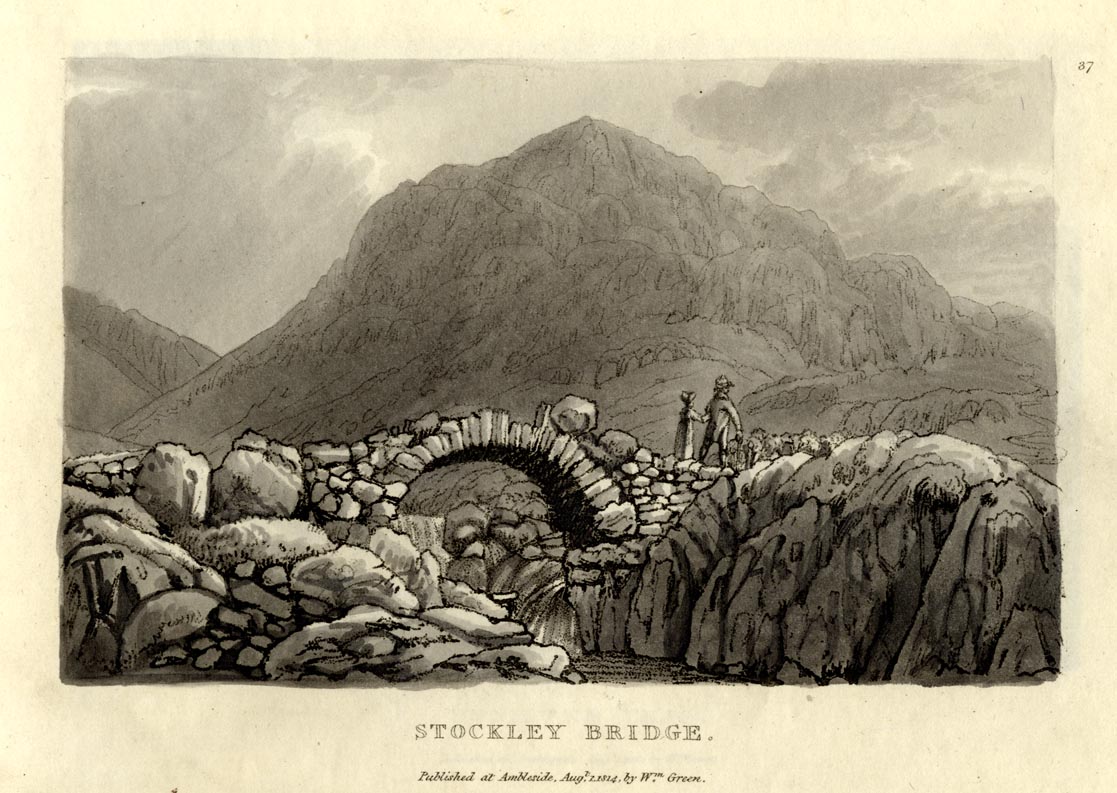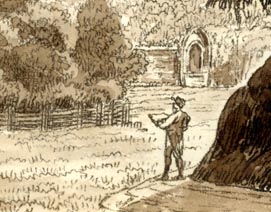


... subscribers may be supplied also by Mr. Green who was an assistant in this work ...
The writer being engaged by Mr. Yates of Liverpool in his survey of Lancaster made Ulverston his primary station for that part of the county which is north of the Sands and here he had the happiness to be noticed by Mr. West who with a fatherly care not only tempered his wild feelings, but taught him how to see and appreciate the lovely wilds of Furness. Were a county-surveyor at the same time landscape draftsman, how great must be his advantages, for traversing every road and climbing every mountain, scenes must be presented to his eye which would rarely be discovered by a professional artist. The writer was encouraged to the pursuit of painting by Mr. West, but why he knows not, his few sketches were humble, his mind untutored and he knew none of the requisite theories, but geometry, perspective and architecture.
...
WARTON CRAG was one of Mr. Yates's primary stations for his survey of Lancashire, and from this place the writer angled to all the surrounding country.
... he is returned from finishing the survey of the County of Lancaster for Wm. Yates, of Liverpool, and therefore at leisure to pursue his own employment of measuring and planning estates ... His terms of land survey and planning are: Estate measuring and mapping 1/- per square acre, measuring land for the content only, six pence per statute acre; for finishing any old plan of estate in the new method, six pence per statute acre, and six pence for every mile the estate lies distant from Manchester (as it is necessary to inspect every field, as Plowed, Pasture, and meadow are differently distinguished, as likewise the fences, whether hedges, walls, cops, dykes, or pales, as likewise hilly ground, etc.; levelling, dividing, etc. according to the time and trouble). ...
... informing the Public, that he has opened a school for ladies at his house at 2 Brazenose Street, in drawing, writing and account, ladies and gentlemen instructed at home and boarding schools attended as usual. ...
... the different modes in which different landscape painters have been taught, and taught themselves to see nature, as it is termed ... yet nature is invariable, ... fully sensible of his [WG's] own defects as an artist, arising in a degree from causes connected with the foregoing observations, the writer settled in Ambleside, in the year 1800, with a view to remedy his errors. The object which had been unceasingly pursued for the last ten years had been to divest himself, as much as possible, of manner, and to adhere as faithfully as possible to nature. ...
... The writer, not only for visual gratification, but for study, prefers Ambleside, ...
... When the writer was in Ambleside in the year 1778 [when surveying for William Yates] its appearance was not only antiquated, but highly picturesque ...
... with no better patrons than the mutable public of lakers, his spirit never flagged, his hand and eye were never idle, and he had a healthy love for his employment such as none but an honest man could understand. ...
... No height or hollow of Helvellyn, no bay or bosky cape in Winander's sinuous length, no shy recess, nor brook, nor fairy waterfall, in all the hills, but there he oft had been - no idle gazer, but indefatigable with book and pencil.
It is nearly nineteen years since the author settled himself in Ambleside, and during that interval he has, annually spent a considerable portion of his time in out-door study, and in the consequent collection of many hundred coloured and pencil drawings, all entirely finished while the subject was before him, for he conceives that studies are lessened in value by being retouched in the house.
...
All the above sketches of mouldering stones, refectory and all, have long since been turned into bread, ... Brethren, blame not the artist, - if a man cannot live by his trade, he must sell such of his tools as he can best spare - the author would sell the accumulated and progressive study of seventeen past summers, to be enabled to draw and paint out of doors in all seasonable weather for three successive years from the present time.
my beloved husband died after a lingering illness on 29 April 1823 at 18 minutes past 4 o'clock in the morning, & was buried 3 May 1823, if he would have lived to the 25 August he would have been 63 years old.
... / WILLIAM GREEN / THE LAST 23 YEARS OF WHOSE LIFE WERE PASSED / IN THIS NEIGHBOURHOOD / WHERE BY HIS SKILL AND INDUSTRY AS AN ARTIST / HE PRODUCED FAITHFUL REPRESENTATIONS / OF THE COUNTY / AND LASTING MEMORIALS OF ITS MORE PERISHABLE FEATURES / ...

Burkett, Mary E & Sloss, J D G: 1984: William Green of Ambleside; a Lake District Artist: Abbot Hall Art Gallery (Kendal, Westmorland):: ISBN 0 9503335 4 9
Hall, Marshall: : Artists of Cumbria: Marshall Hall Associates:: ISBN 0 903858 01 0
 William Green: 1790's-1820's and Biography
William Green: 1790's-1820's and Biography